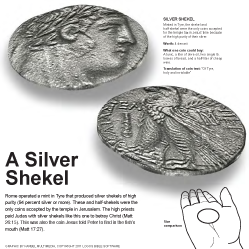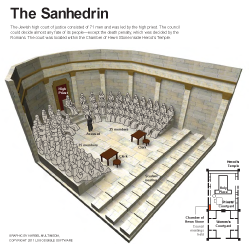26:1–5 At this point, Matthew’s narrative shifts from Jesus’ ministry and teaching to the events that lead to His death. |
26:1 all these sayings Refers either to 24:4–25:46 or to all that Jesus has taught in Matthew.
26:2 Passover An annual Jewish feast commemorating the Israelites’ deliverance
commemorating the Israelites’ deliverance from slavery in Egypt (Exod 12–13; see note on Luke 2:41). Jerusalem would have been crowded with Jewish pilgrims who came to celebrate Passover in the holy city.
from slavery in Egypt (Exod 12–13; see note on Luke 2:41). Jerusalem would have been crowded with Jewish pilgrims who came to celebrate Passover in the holy city.
Son of Man See Matt 8:20 and note.
26:3 chief priests and the elders of the people Refers to members of the Sanhedrin, the Jewish ruling body in Jerusalem.
Caiaphas The acting high priest. John’s Gospel indicates that Caiaphas’ predecessor and father-in-law, Annas, still held some authority at this time (John 18:12–13, 19–24).
John’s Gospel indicates that Caiaphas’ predecessor and father-in-law, Annas, still held some authority at this time (John 18:12–13, 19–24).
 Political Leaders in the New Testament Table
Political Leaders in the New Testament Table
High Priests in the nt | |
Annas (Luke 3:2; John 18:13, 24; Acts 4:6) | ad 6–15 |
Caiaphas (Matt 26:3, 57; Luke 3:2; John 11:49; 18:13, 14, 24, 28; Acts 4:6) | ad 18–36 |
ad 47–58 | |
26:4 by stealth The Greek word used here, dolos, carries a sense of underhandedness, cunning, or treachery. Matthew might employ this term to portray the religious establishment as being guilty and wicked, in contrast to Jesus’ innocence and righteousness.
26:5 the feast Refers to Passover (see note on Matt 26:2).
an uproar among the people Civil unrest was a constant threat during festival times, due to the influx of peasants into the city. The Romans often suppressed riots harshly.
26:6–13 As Jesus and His disciples eat at their host’s home in Bethany, a woman enters the house and anoints Jesus’ head with costly perfume. |
26:6 Bethany See 21:17 and note.
Simon the leper Most likely, Simon had been cleansed from his skin disease; he would have been required to live in isolation had it not been healed (Lev 13:46). He might have been among those healed by Jesus. Luke’s parallel account presents Simon as a Pharisee (Luke 7:36–40).
26:7 a woman John’s parallel account identifies her as “Mary”—presumably the sister of Martha and Lazarus (John 12:3).
26:9 large sum Mark’s parallel account says the oil was worth more than 300 denarii, roughly one year’s wages (Mark 14:5).
given to the poor The disciples’ concern for the poor is in keeping with the heart of Jesus’ ministry.
26:12 in order to prepare me for burial The woman likely intended to display her devotion, but Jesus reinterprets her act.
26:14–16 Judas seeks out the chief priests, who were involved in Jewish religious government, in order to betray Jesus. In John’s Gospel, Judas seems to be motivated (at least in part) by his objection to the extravagant anointing that occurs in the previous scene (John 12:4–6). |
26:15 thirty silver coins Approximately equal to four months’ wages (see Matt 27:9 and note).
26:17–25 Jesus eats the Passover meal with His disciples and reveals that one of them will betray Him. |
26:17 first day of the feast of Unleavened Bread The day of preparation for Passover.
of preparation for Passover.
26:20 he was reclining at table The setting likely involved a low table, with guests leaning on cushions.
26:23 dips his hand in the bowl This statement probably is intended to emphasize the betrayer’s breach of fellowship, not to single out a disciple (i.e., Judas) who had his hand in the bowl at the same moment as Jesus. Compare John 13:26–30.
26:25 Rabbi Judas’ query differs from that of the other disciples (Matt 26:22). Throughout Matthew’s Gospel, only those who show faith in Jesus call him “Lord.”
You have said it Jesus confirms that Judas is the betrayer.
is the betrayer.
26:26–30 As the meal continues, Jesus gives His disciples the bread and cup as sacraments |
26:26 Take, eat, this is my body Jesus’ body was the final sacrifice that would atone for sins, just as the Passover lamb signified the atonement for the people’s sins every year (Lev 16).
26:27 after taking the cup The Passover meal includes four (sometimes five) cups of wine; this is likely the third, the cup of blessing.
26:28 my blood of the covenant In the ancient Near East, covenants often were ratified using blood (through sacrifice). At Sinai, Moses sprinkled the people with the blood of the covenant (Exod 24:8). The elements of the Lord’s Supper serve as signs of the new covenant (Jer 31:31–34).
serve as signs of the new covenant (Jer 31:31–34).
poured out for many Compare Matt 20:28.
26:29 drink it new with you Likely a reference to the messianic banquet (see 8:11 and note).
26:30 the hymn Refers to portions of Pss 113–118.
26:31–56 Jesus states that the disciples—even Peter—will abandon Him. He takes them to a secluded place to pray, but the disciples, failing to grasp the urgency of His distress, fall asleep. A short time later, an armed mob led by Judas arrives to arrest Jesus. As predicted, the disciples flee. |
26:31 you will all fall away Jesus predicts that His disciples will abandon Him that very night.
I will strike the shepherd Jesus quotes Zech 13:7.
 Jesus’ Fulfillment of Old Testament Prophecy Table
Jesus’ Fulfillment of Old Testament Prophecy Table
26:36 Gethsemane See note on Mark 14:32.
26:37 Peter and the two sons of Zebedee Peter, James, and John (see Matt 17:1 and note).
26:38 stay awake with me The Greek word used here, grēgoreō (“to be awake” or “watchful”), appears in Jesus’ teachings in 24:42 and 25:13 to stress the importance of being ready for the Son of Man’s arrival.
26:39 this cup Refers to suffering (compare 20:22–23).
26:47 one of the twelve This detail magnifies the treachery of Judas’ betrayal.
betrayal.
26:48 the one whom I kiss A customary greeting.
26:50 Friend Compare 20:13; 22:12. In Matthew, the word hetairos (meaning “friend,” “comrade,” or “companion”) always appears in direct addresses, and always in a response from a righteous figure to a wicked person.
26:51 one of those with Jesus Identified in John 18:10 as Peter.
cut off his ear In Luke’s account, Jesus heals the man (Luke 22:51).
26:53 twelve legions of angels A Roman legion had about 5,000–6,000 soldiers, so this indicates at least 60,000 angels.
26:57–68 Jesus is tried before the Jewish religious leaders and condemned to death on a charge of blasphemy. |
26:59 Sanhedrin See note on Luke 22:66.
26:61 rebuild it within three days This saying does not appear in Matthew. John 2:19 records Jesus making a similar statement, but the false witnesses clearly misunderstand the statement, which is about Jesus’ death and resurrection. The intention of the testimony is entrapment.
26:63 Jesus was silent Compare Isa 53:7.
tell us if you are the Christ The witnesses do not give Caiaphas the evidence he needs, so he hopes to get a straight answer from Jesus: Is He the Messiah?
26:64 You have said it Jesus answers indirectly but affirmatively.
the Son of Man A messianic title connected to royal authority. See Matt 8:20 and note.
sitting at the right hand of the Power and coming on the clouds With this phrase, Jesus clearly identifies Himself as the Messiah. In Psa 110:1, Yahweh invites the Messiah to sit at His right hand in authority (compare Matt 22:44). Thus, Jesus is saying that He will be in the position of ultimate authority over humanity, as the Messiah.
26:65 tore his robes This gesture symbolizes extreme grief.
He has blasphemed Refers to claiming authority that belongs to God alone.
What further need do we have of witnesses Jesus essentially condemns Himself by agreeing with Caiaphas that He is the Messiah, the Son of God—and He further condemns Himself by claiming to be the Son of Man (Dan 7:13–14).
(Dan 7:13–14).
26:66 He deserves death The prescribed punishment for blasphemy (Lev 24:16).
26:69–75 When people recognize Peter as one of the disciples, he denies any association with Jesus—fulfilling Jesus’ prophecy in Matt 26:34. |
26:72 he denied it with an oath In his second denial, Peter swears an oath—a call for divine judgment if the oath-taker is lying. Jesus taught against oaths (5:33–37).
26:73 even your accent reveals who you are Peter speaks as a Galilean.
26:74 to curse and to swear with an oath Peter’s third denial adds a curse to the oath. The meaning of this detail is not clear; it does not necessarily refer to using profanity.
immediately a rooster crowed See v. 34.

|
About Faithlife Study BibleFaithlife Study Bible (FSB) is your guide to the ancient world of the Old and New Testaments, with study notes and articles that draw from a wide range of academic research. FSB helps you learn how to think about interpretation methods and issues so that you can gain a deeper understanding of the text. |
| Copyright |
Copyright 2012 Logos Bible Software. |
| Support Info | fsb |
 Loading…
Loading…




